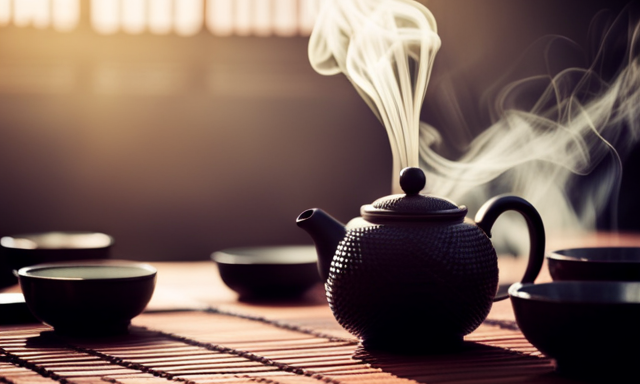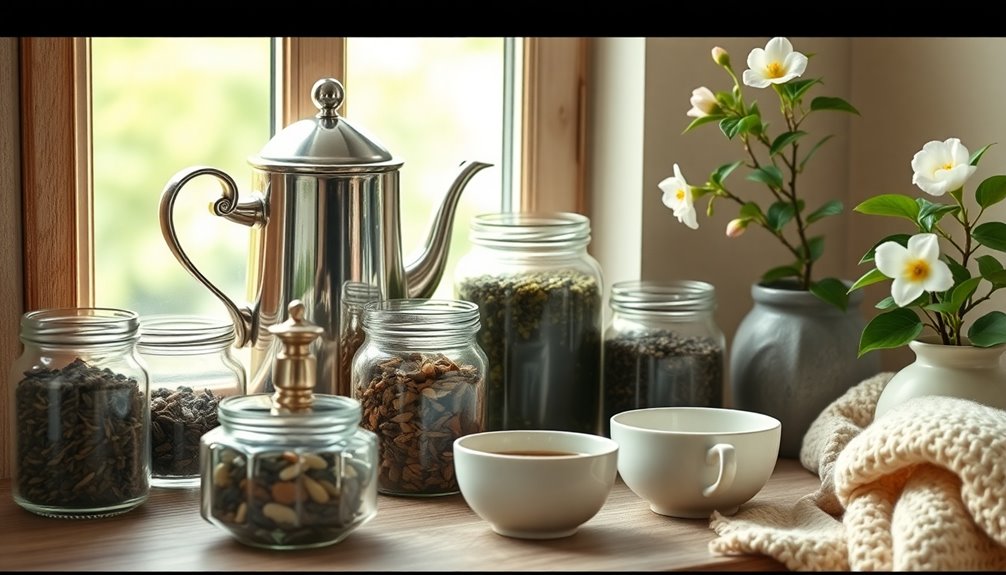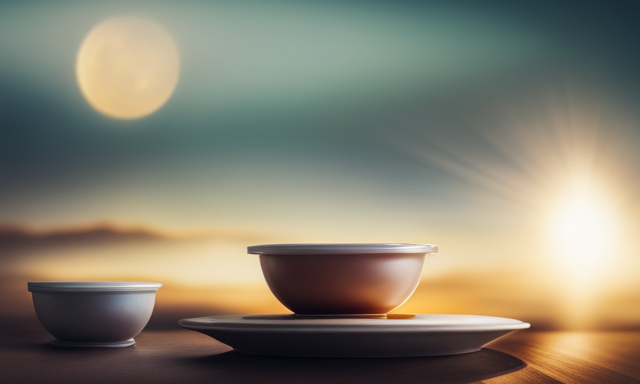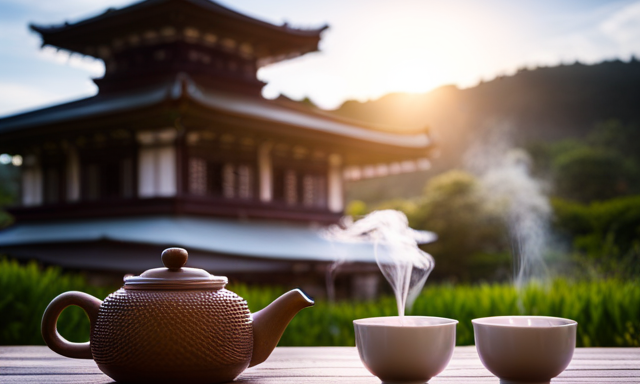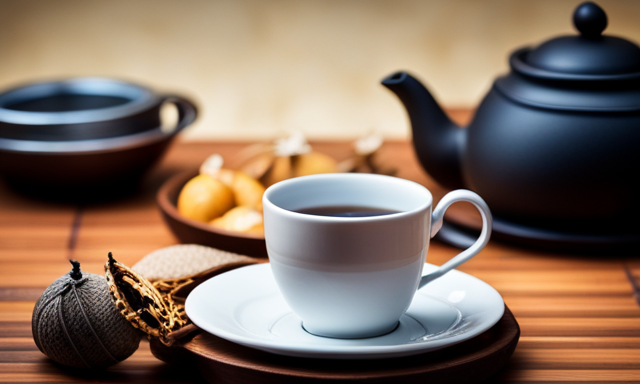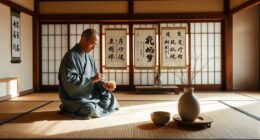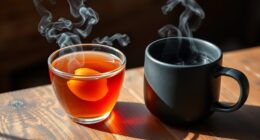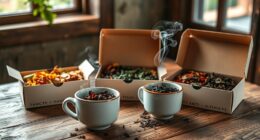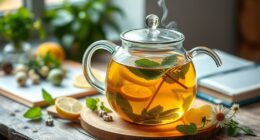As someone who loves tea, I am constantly searching for special and tasty blends.
One such tea that has captured my attention is oolong tea, a traditional Chinese tea with a rich history and exquisite taste. Oolong tea, known as ‘Wulong’ in Chinese, is a partially oxidized tea that falls between green and black tea in terms of flavor and color. Its production involves meticulous techniques that have been honed over centuries, resulting in a tea that is complex and nuanced in taste.
From floral and fruity to toasty and earthy notes, oolong tea offers a wide range of flavors to suit every palate. Not only does it please the senses, but it also boasts numerous health benefits, such as aiding digestion and boosting metabolism.
Whether you’re a tea connoisseur or just starting your tea journey, oolong tea is an exciting and delicious choice that will leave you craving for more.
Key Takeaways
- Oolong tea is a traditional Chinese tea with a rich history and unique flavor.
- It is a partially oxidized tea that falls between green and black tea in terms of flavor and color.
- Oolong tea production involves meticulous techniques honed over centuries.
- Oolong tea offers a wide range of flavors, from floral and fruity to toasty and earthy.
Origins of Oolong Tea in Chinese Tradition
Oolong tea, with its rich and complex flavors, has a fascinating history deeply rooted in ancient Chinese tradition. Chinese tea culture dates back thousands of years, and tea has played a significant role in the country’s history and daily life.
The history of tea in China is a tale of discovery, cultivation, and refinement. It is believed that tea was first discovered by the legendary Emperor Shennong in 2737 BCE. Since then, it has become an integral part of Chinese society, with various tea ceremonies and customs developed over time.
Oolong tea, in particular, has a unique production process that sets it apart from other types of tea. This includes withering, rolling, oxidation, and firing. These production methods contribute to the distinctive flavor profile of oolong tea.
Production Methods of Oolong Tea
Brewed to perfection, this masterfully crafted beverage is the result of a meticulous process that combines the artistry of traditional methods with the precision of modern techniques.
Oolong tea, known for its distinct flavor and aroma, undergoes a unique production method that sets it apart from other teas. The oxidation levels play a crucial role in determining the characteristics of oolong tea.
The leaves are carefully plucked and withered under controlled conditions to allow for partial oxidation. This step is followed by a process known as shaking, where the leaves are gently agitated to bruise the edges, initiating further oxidation. The oxidation process is then halted by heating the leaves, which preserves the delicate balance of flavors.
These intricate and precise processing techniques result in the exquisite taste and complexity of oolong tea.
As we delve into the different varieties of oolong tea, the true essence of this remarkable brew will be revealed.
Different Varieties of Oolong Tea
Indulge your senses with the diverse array of flavors and aromas that await you in the world of oolong tea varieties.
Oolong tea is produced using a unique combination of production methods that result in its distinct characteristics. The leaves are partially oxidized, giving oolong tea its signature flavor profile that falls between green and black tea. This process involves withering the leaves, then gently shaking and bruising them to start the oxidation process. After that, the leaves are heated to stop the oxidation and then rolled into tight, twisted shapes.
The different varieties of oolong tea can vary in oxidation levels, ranging from light and floral to dark and robust.
In addition to its rich taste, oolong tea is also known for its numerous health benefits. It contains antioxidants, promotes heart health, aids digestion, and can even help with weight management.
As we move into the next section about the flavor profile of oolong tea, you’ll discover the delightful nuances that make each variety unique.
Flavor Profile of Oolong Tea
Savor the tantalizing dance of flavors as your taste buds are transported to a picturesque garden blooming with delicate floral notes and hints of fruity sweetness. Oolong tea offers a wide range of flavor profiles, making it a versatile and enjoyable beverage. Depending on the variety and brewing techniques, oolong tea can have a spectrum of flavors, from light and floral to bold and roasted. The level of oxidation also plays a crucial role in determining the flavor profile. For instance, lightly oxidized oolong teas tend to have a fresh, grassy taste, while heavily oxidized ones exhibit a rich and robust character. To fully appreciate the intricate flavors, it is essential to master the art of brewing. By controlling the water temperature and steeping time, you can unlock the tea’s full potential. As we explore the health benefits of oolong tea, let’s delve into the secrets of this captivating brew.
Health Benefits of Oolong Tea
Discover the amazing health benefits you can reap from enjoying a cup of this exquisite and flavorful beverage. Oolong tea, a traditional Chinese tea, offers numerous advantages for both weight loss and skin health.
-
Oolong tea and weight loss: This tea is known to boost metabolism and promote fat oxidation, making it an excellent addition to any weight loss regimen. It can also help regulate blood sugar levels, reducing cravings and aiding in weight management.
-
Oolong tea and skin health: Packed with antioxidants, oolong tea helps fight free radicals that cause skin damage and premature aging. Regular consumption of oolong tea can result in clearer, more youthful-looking skin, reducing the appearance of wrinkles and blemishes.
Transitioning into the subsequent section about brewing techniques for oolong tea, let’s delve into the art of preparing this delightful beverage.
Brewing Techniques for Oolong Tea
When it comes to brewing techniques for oolong tea, two key factors to consider are water temperature and steeping time. To achieve the perfect brew, water should be heated to around 190-200 degrees Fahrenheit and steeped for 2-3 minutes.
Additionally, traditional teaware and brewing rituals are essential for an authentic oolong tea experience. Using a Gaiwan or Yixing teapot and following traditional brewing methods can enhance the flavor and aroma of the tea, allowing you to fully appreciate the intricate nuances of this beloved beverage.
Water temperature and steeping time
To get the perfect cup of oolong tea, you should steep it for 3 minutes at a water temperature of 190°F, allowing the leaves to unfurl and release their rich flavors. Here are some tips to help you achieve the best results:
- Use filtered or spring water for brewing, as impurities can affect the taste.
- Invest in a good quality kettle with temperature control to ensure accuracy.
- Preheat your teapot or teacup with hot water before adding the tea leaves.
- Measure the tea leaves accurately. A general guideline is 1 teaspoon of leaves per 8 ounces of water.
- Experiment with steeping times to find your preferred strength. Oolong tea can be steeped multiple times, with each infusion offering a unique flavor profile.
Now that you’ve mastered the art of brewing oolong tea, let’s explore the traditional teaware and brewing rituals that enhance the overall experience.
Traditional teaware and brewing rituals
Enhance your oolong tea experience by embracing the traditional teaware and brewing rituals passed down through generations.
In Chinese tea ceremonies, the use of traditional teaware is highly valued for its ability to enhance the flavor and aroma of oolong tea. The teapot, typically made of clay, is an essential component of the teaware. Its porous nature helps to absorb the flavors of the tea, resulting in a more robust and well-rounded taste.
The tea cups, usually small and delicate, allow for a more focused appreciation of the tea’s aroma and color. The process of brewing oolong tea in traditional teaware involves precise measurements, careful pouring, and a mindful focus on the tea leaves as they unfurl and release their flavors. By engaging in these rituals, you can fully immerse yourself in the art and culture of oolong tea.
Transitioning into the subsequent section about ‘best pairings with oolong tea,’ let’s explore the delightful combinations that complement the rich and complex flavors of this beloved beverage.
Best Pairings with Oolong Tea
For a delightful dance on your taste buds, pair your Oolong tea with a symphony of flavors like dark chocolate or roasted almonds. The best food pairings for Oolong tea are carefully selected to enhance its unique characteristics.
Oolong tea ceremonies often include small bites of food that complement the tea’s flavors. Dark chocolate is an excellent choice as it provides a rich, slightly bitter note that balances the tea’s floral and fruity undertones. Roasted almonds, on the other hand, offer a nutty and toasty flavor that enhances the tea’s earthy and roasted notes.
These pairings create a harmonious blend of flavors that elevate the Oolong tea experience.
Moving on to Oolong tea in modern culture, its popularity has soared in recent years as more people discover its complex taste and numerous health benefits.
Oolong Tea in Modern Culture
Immerse yourself in the modern culture surrounding Oolong tea and discover its soaring popularity and numerous health benefits. Oolong tea has not only found its way into our cups, but also into the realms of art and fashion.
-
Oolong tea has become a muse for artists, who capture its elegance and beauty in paintings and sculptures. The delicate leaves and rich amber color are portrayed with intricate brushstrokes, creating masterpieces that evoke a sense of tranquility and sophistication.
-
Fashion designers have also embraced the allure of Oolong tea, incorporating its essence into their creations. From ethereal gowns with flowing silhouettes to accessories adorned with tea leaf motifs, Oolong tea has become a symbol of refinement and grace on the runway.
-
With its artistic and fashionable influence, it’s no wonder that Oolong tea has become a sought-after beverage. But where can you find and buy this exquisite tea? Let’s explore the next section to uncover the best places to indulge in the world of Oolong tea.
Where to Find and Buy Oolong Tea
When it comes to finding and buying Oolong tea, there are a few key options to consider. First, there are several famous tea-producing regions in China that are known for their exceptional Oolong teas. These regions include Fujian, Guangdong, and Taiwan.
Second, specialty tea shops are a great place to explore a wide variety of Oolong teas, often sourced directly from the tea gardens.
Finally, online retailers offer a convenient way to access a large selection of Oolong teas, with the added benefit of detailed descriptions and customer reviews to inform your purchasing decision.
Famous tea-producing regions in China
Although known for its complex flavor profiles, oolong tea, a Chinese specialty, is predominantly produced in the regions of Fujian and Guangdong. These famous tea-producing regions in China have a long history of cultivating and crafting oolong tea.
The unique terroir, with its specific climate, soil, and altitude, contributes to the distinctive taste and aroma of the tea. Traditional teaware and brewing rituals are integral to the oolong tea experience in these regions. From the delicate Yixing clay teapots to the precise temperature and timing for steeping, every aspect is carefully considered to bring out the best flavors.
As a result, oolong tea from Fujian and Guangdong is highly sought after by tea connoisseurs around the world.
Moving forward to explore specialty tea shops and online retailers, these establishments offer a wide selection of oolong teas to further indulge in this exquisite beverage.
Specialty tea shops and online retailers
Moving on from discussing the famous tea-producing regions in China, let’s now explore the world of specialty tea shops and online retailers. These establishments offer a wide range of tea options, including the highly sought-after oolong tea. Specialty tea shops are often found in major cities and provide a unique and immersive tea-buying experience. They have knowledgeable staff who can guide you through the different types of oolong tea and help you find the perfect one to suit your taste preferences. On the other hand, online retailers offer convenience and accessibility, allowing you to explore and purchase oolong tea from the comfort of your own home. They often have a vast selection of teas from various regions, making it easier to find rare and exotic oolong varieties. To give you a visual representation, here’s a table showcasing some of the best specialty tea shops and online retailers:
| Specialty Tea Shops | Online Retailers |
|---|---|
| Teavana | Adagio Teas |
| David’s Tea | Art of Tea |
| T2 | Harney & Sons |
| The Tea Spot | Tea Forte |
Whether you choose to visit a specialty tea shop or explore online retailers, you can be sure to find a diverse selection of oolong teas to satisfy your tea cravings.
Frequently Asked Questions
How many different varieties of oolong tea are there?
There are numerous varieties of oolong tea, each offering unique flavors and characteristics. The number of different flavors is vast due to the various stages of oolong tea processing, which include withering, rolling, oxidation, and firing.
Can oolong tea help with weight loss?
Yes, oolong tea can help with weight loss. It has various benefits, including boosting metabolism. While results may vary, incorporating oolong tea into a healthy diet and exercise routine can support your weight loss goals.
What is the ideal brewing temperature and time for oolong tea?
The ideal brewing temperature for oolong tea is between 180°F and 190°F, while the ideal brewing time is around 3-5 minutes. This temperature range allows the tea to release its flavors and aromas, resulting in a perfect cup of oolong tea.
Are there any specific health risks associated with consuming oolong tea?
I investigated the truth of the theory and found that while oolong tea has potential benefits for heart health, there are no specific health risks associated with consuming it.
How does oolong tea differ from other types of Chinese tea, such as green or black tea?
Oolong tea, unlike green or black tea, offers a unique flavor profile that falls between the two. It has a rich, complex taste with floral and fruity notes. In addition, oolong tea benefits include boosting metabolism and promoting heart health.
Conclusion
In conclusion, oolong tea holds a significant place in Chinese tradition and has gained popularity worldwide due to its unique flavor profile and potential health benefits. It has various production methods and different varieties to choose from, offering a wide range of options for tea enthusiasts. One interesting statistic to note is that oolong tea accounts for approximately 2% of the total tea consumption globally, showcasing its niche appeal. To experience the wonders of oolong tea, explore reputable tea shops or online platforms that offer a diverse selection of this exquisite beverage.

